
For ALL WOMEN who are 50-69 years old
ᐋᒋᔦ ᓃᒋᓴᓂᔅᐧᑫᒻ
Wachiyeh Niichisaniskwem!
wîpich chi kâ pâpihyâuch kilerâ pus kiyâh sûvi erâ ihtâwinh chi kâ nânituchischâyimâkanûwich iskwâûhch utûtûshimh kâ muwiwâch âhkusiwin wiyich
will be coming soon
chîyi âpâyikushîn chi kâ wiyâyihtim châ chi nânituchischâyimâkawîyin kâ muwiwâch âhkusiwin wîyich GETTING SCREENED FOR BREAST CANCER IS YOUR CHOICE!
For women aged 35-49 years old
If you have a biological family history of breast or ovarian cancer, check with your doctor for more information about the best time to get screened.
2023 Tour Dates
CHISASIBI
Thursday, March 2 to Tuesday, March 21
CMC: (819) 855-2744
Doris Duff Ext. 22212
For more information:
PCCRs Patricia Bobbish, Delores Kitty or Cody Napash
WHAPMAGOOSTUI
Dates to be determined
Women will be flown to Chisasibi for the day
CMC: (819) 919-3372
PCCRs Pasha Abraham or Judy Masty
For more information:
PCCRs Pasha Abraham or Judy Masty
WEMINDJI

Thursday, March 23 to Monday, March 27
CMC: (819) 978-0225
Tina Atsynia Ext. 23307
For more information:
PCCR Laurie Ann Georgekish
EASTMAIN
Wednesday, March 29 to Friday, March 31
CMC: 819-977-0241
Gloria Moar Ext. 24228
For more information:
PCCR Rena Gilpin
*All other communities are planned for summer/fall 2023
to offer breast cancer screening in Eastmain, Wemindji, Chisasibi, and Whapmagoostui You will receive a letter from the Public Health Department creehealth.org/services/breast-cancer-screening
ᐐᐱᒡ
ᒋ ᑳ ᓈᓂᑐᒋᔅᒑᔨᒫᑲᓅᐎᒡ
ᐅᑑᑑᔑᒻᐦ
ᒋ ᑳ ᐹᐱᐦᔮᐅᒡ ᑭᓓᕌ ᐳᔅ ᑭᔮᐦ ᓲᕕ ᐁᕌ ᐃᐦᑖᐎᓐᐦ
ᐃᔅᒀᐆᐦᒡ
ᑳ ᒧᐎᐙᒡ ᐋᐦᑯᓯᐎᓐ ᐎᔨᒡ
ᒌᔨ ᐋᐹᔨᑯᔒᓐ ᒋ ᑳ ᐎᔮᔨᐦᑎᒻ ᒑ ᒋ ᓈᓂᑐᒋᔅᒑᔨᒫᑲᐐᔨᓐ ᑳ ᒧᐎᐙᒡ ᐋᐦᑯᓯᐎᓐ ᐐᔨᒡ
Facebook: Cree Health - Breast Cancer Screening
To learn more :

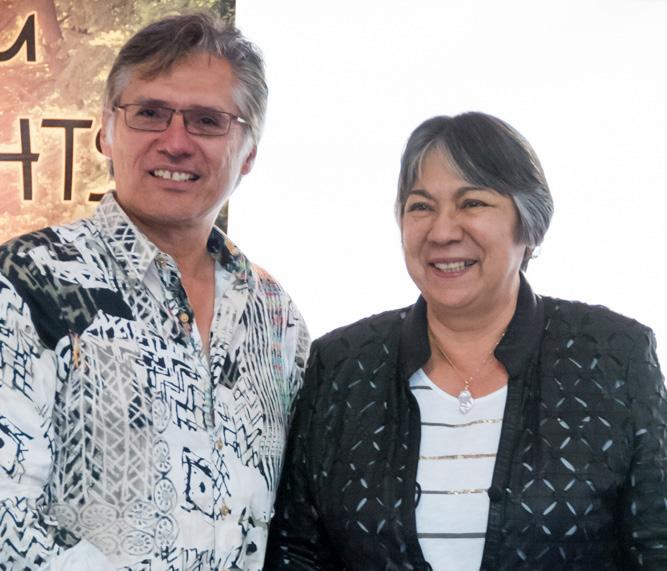
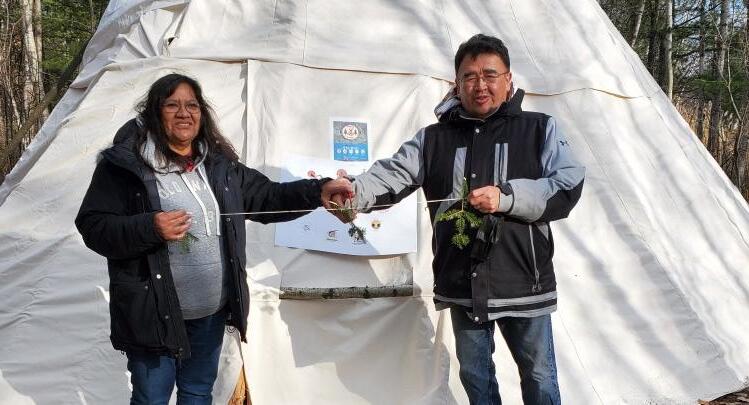




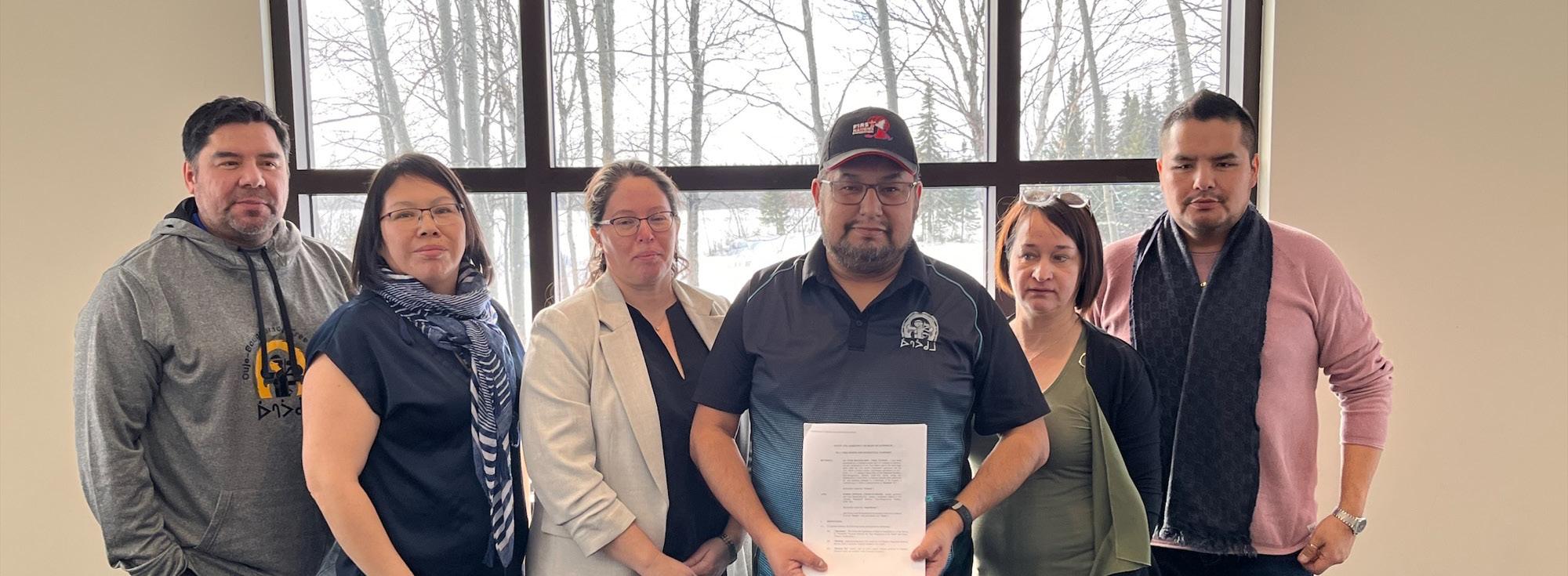

CONT ENTS 16 Mohawk-Cree Teepee project 10 1 800 361-2965 1 800 661-5850 ᐅᕙᓂ ᐱᒋᐊᕐᐳᖅ ᓄᓇᕕᒃ Nunavik Starts Here RESERVATIONS 1 800 361-2965 ᖃᖓᑦᑕᔫᓂᒃ ᐊᑦᑕᑐᐊᖃᕐᓂᖅ CHARTERS 1 800 661-5850 ᐅᕙᓂ ᐱᒋᐊᕐᐳᖅ ᓄᓇᕕᒃ Nunavik Starts Here Historic home ownership transfer Celebrating Bella Petawabano Grand opening event in Kahnawake 20 Photo provided by Philip Matoush EDITORIAL Paying what you owe NEWS Taking the reins Literary reconciliation BRIEFS FEATURES A home away from home Bella’s honours Unlocking the wealth Not a drop to drink A big tent PUZZLES REZ NOTES Back to the grind T&B The trickster is online 4 5 6 9 10 16 20 22 23 24 25 26 Community
Paying what you owe
 by Will Nicholls
by Will Nicholls
Promises forgotten, treaties not honoured and fiduciary obligations unfulfilled underly the relationship First Nations have lived with both federal and provincial governments. In most cases it means going to courts for justice, to make our partners live up to their signatures. It’s an uneven battle, as many First Nations have limited funds to pay for lawyers and court costs compared to unlimited government resources.
In fact, some payouts have come close to the amount the governments have spent on legal fees to fight First Nation legal cases. In many cases, the years waiting through appeals, delays and technical manoeuvres make a mockery of the justice system.
For example, Zongidaya Nelson of the Roseau River Anishinaabe First Nation in Manitoba is the lead plaintiff in a case seeking $11 billion in compensation from the Canadian government on behalf of Treaty 1 status members. It includes damages, compensation and interest for more than 150 years of non-compliance by Canada.

Nelson says the Crown failed to uphold treaty obligations by ignoring inflation when determining payments to status members. The claims say that the government did not consult members on the amount of the $5 per year annuity.
“We were left without the ability to access finances, goods and tools which would foster our equal participation in a foreign economy which the Crown forced upon us,” said Nelson. He added that reconciliation is tied to modernizing the annuity payments.
Included in the case is a reference to the Robinson treaties of 1850 where the Crown agreed that annuities would be
increased as revenues from those lands increased.
The case invokes the United Nations Declaration on the Rights of Indigenous Peoples, which was adopted by Canada. It entitles First Nations to seek restitution for treaty violations and for land and resources that were taken from them. This is only one of many cases that First Nations and the Inuit have before the courts.
A spokesperson for Crown-Indigenous Relations and Northern Affairs said, “More needs to be done with regards to renewing the treaty relationship.” He added the government will continue to work with First Nations to advance treaty relationships and work to ensure reconciliation becomes a reality.
If that is the truth, why is it so hard to pay what is owed without a battle in the courts? Why is it so hard to understand the pain a person feels when their children are taken from them? The loss of murdered and missing women and girls without real police investigations? The systematic racism First Nations people experience to this day despite commissions and court cases?
It’s not just about paying what Canada owes in monetary or fiduciary obligations but what they owe in terms of equality for all Canadians. What every Canadian expects from Canada or their province is not what any First Nations person will receive. It’s time to understand what should be paid to let First Nations know they are just as important as anyone else.
THANKS TO: Air Creebec
CONTACT US: The Nation News, 918-4200 St. Laurent, Montreal, QC., H2W 2R2 EDITORIAL & ADS: Tel.: 514-272-3077, Fax: 514-278-9914


OFFICE: P.O. Box 151, Chisasibi, QC. J0M 1E0 www.nationnews.ca EDITORIAL: will@nationnews.ca news@nationnews.ca ADS: Danielle Valade: ads@nationnews.ca; Donna Malthouse: donna@beesum.com
SUBSCRIPTIONS: $60 plus taxes, US: $90, Abroad: $110, Payable to beesum communications, all rights reserved, publication mail #40015005, issn #1206-2642 The Nation is a member of: The James Bay Cree Communications Society, Circle Of Aboriginal Controlled Publishers, Magazines Canada Quebec Community Newspaper Assn. Canadian Newspapers Assn. Les Hebdos Sélect Du Québec. Funded [in part] by the Government of Canada. | www.nationnews.ca | facebook.com/NATIONnewsmagazine | Twitter: @creenation_news
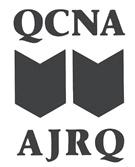
4 the Nation February 24, 2023 www.nationnews.ca
The
EDITORIAL
Nation is published every two weeks by Beesum Communications
BOARD L. Stewart, W. Nicholls, M. Siberok, Mr. N. Diamond, E. Webb EDITOR IN CHIEF Will Nicholls DIRECTOR OF FINANCES Linda Ludwick EDITORS Lyle Stewart, Martin Siberok PRODUCTION COORDINATOR AND MANAGING EDITOR Randy Mayer CONTRIBUTING WRITERS S. Orr,
M. Labrecque-Saganash, P. Quinn, B. Powless DESIGN Matthew Dessner SALES AND ADVERTISING Danielle Valade, Donna Malthouse
HEAD
CMC A AUDITED Editorial
It’s not just about paying what Canada owes in monetary or fiduciary obligations but what they owe in terms of equality for all Canadians
Taking the reins
George Pachano appointed CEO of Cree Development Corporation
by Ben Powless, Local Journalism Initiative Reporter
The Cree Development Corporation (also known as the James Bay Native Development Corporation) has appointed George E. Pachano as its Chief Executive Officer.

Starting in September 2018, Pachano served as Director General of Whapmagoostui First Nation, and previously worked for eight years as the Capital Projects Manager for Chisasibi. He also spent 10 years with the Cree Construction and Development Company.
“I am honoured to become the new CEO of the CDC/SODAB and participate in the development of my nation,” Pachano said in a statement. “I have always been a believer in the fact that projects happening on the territory should be Cree-led, hiring local workers as much as possible.”
CDC Chairperson Katherine Moses noted that development must be reconciled with the need to protect the land and wildlife. “Mr. Pachano has the experience and community perspective needed to empower the Eeyou Istchee communities through sustainable development,” she said.
Pachano has earned degrees and certificates in Project Management, Business Administration and Human Resources Management from Algonquin College, McGill University and Northern College of Applied Arts and Technology, according to his LinkedIn.
Pachano was appointed in December and began working in January, but the position was only announced by the CDC in February. Davey Bobbish had served as the organization’s president until September 2022, when he was tapped to take over as CNG Executive Director.
Editorial News
Toronto School Board makes Indigenous Voices course mandatory for students
by Patrick Quinn Local Journalism Initiative Reporter
Education advocates are hopeful that an initiative from Canada’s largest school board to establish a compulsory course focused on Indigenous writers for all secondary students will send a strong message across the country.
The Toronto District School Board (TDSB) voted 18 to 3 on February 1 to replace its mandatory Grade 11 English course with one titled “Understanding Contemporary First Nations, Métis and Inuit Voices”. While the course is already offered in 29 TDSB schools, it will gradually be implemented in a “culturally responsive and trauma-informed” way in all its 110 institutions.
“I think this will send a ripple effect across Canada,” said Indigenous student trustee Isaiah Shafqat, who is the driving force behind the initiative. “Now that every student who graduates from the TDSB will have an understanding of Indigenous history, reality and culture, I would expect to see a bigger commitment to truth and reconciliation from the younger generation.”
Shafqat, a two-spirit Mi’kmaq and Loon clan student at Kâpapâmahchakwêw Wandering Spirit School, began planning this motion about two years ago. After speaking with Elders, Indigenous students, community members and TDSB staff, they determined the time was right to push for change.
“Education is the starting point for a lot of critical and transformative change,” Shafqat told the Nation. “When we are uplifting Indigenous voices, we are sharing the truth and our lived experiences. There has been an overwhelming amount of support.”
While there has been backlash over eliminating literary classics by William Shakespeare and Charles Dickens, Shafqat emphasized the school board is simply dedicating one of 30 high school courses to Indigenous themes. Developed by Ontario’s Education Ministry as an alternative English course, it explores a range of Indigenous literary, oral, media and cultural texts.
The reading list includes Richard Wagamese’s Indian Horse, Thomas King’s Green Grass, Running Water and Tanya Talaga’s Seven Fallen Feathers. Talaga said the course signifies an “incredibly needed change”, adding

6 the Nation February 24, 2023 www.nationnews.ca
Include the Nation in your next budget! How can your promotional campaign not be seen by the Cree Nation with these stats: • 7,000 copies every two weeks, free to all Crees • Distributed to every Cree community and beyond • 13,000 web visitors on the Nation site per month • Found in every seat of Air Creebec flights • Award-winning news magazine since 1993 YOUR GATEWAY TO AMAZING PROMO SUCCESSES! www.nationnews.ca Contact us to discuss options and get a quote on an ‘Annual Contract’ or a ‘Multiple ad campaign’... SAVE BIG WITH OUR BULK RATES! We look forward to working with you, let us tailor all your advertising needs in print or online. DIVE INTO THE POSSIBILITIES. Danielle Valade ads@nationnews.ca | 514-777-7505 Donna Malthouse donna@beesum.com | 514-943-6191
Literary reconciliation
that “it’s really important that Canadians, no matter how old they are, know the true history of this country.”
Teachers will be trained to decolonize their practices, centre Indigenous pedagogy and appropriately integrate the 4 Rs of education: relevance, reciprocity, respect and responsibility. Shafqat finds there is more reciprocity in teaching methods in these classes, where everyone is learning together.
Although the course is dedicated to improving English language competencies, it’s also an opportunity to delve into historical and contemporary Indigenous issues. In Shafqat’s experience, teachers give students more space to absorb this difficult part of Canadian history.
“There is a focus on the harsh histories but there’s also a focus on Indigenous joy and resurgence, talking about the success of our people across the country,” explained Shafqat. “Some issues that come up, for example, will be the Mi’kmaq fishing dispute on the east coast or Grassy Narrows – I know in my class last year we talked about the Kanesatake Resistance or Oka Crisis.”
After the Truth and Reconciliation Commission report seven years ago, school boards across Canada began slowly addressing its call to action for “age-appropriate curriculum on residential schools, treaties and Indigenous peoples’ historical and contemporary contributions a mandatory education requirement for kindergarten to Grade 12 students.”
Next September, Ontario will launch a mandatory social studies curriculum
being developed for Grades 1-3, which includes an introduction to the residential school system and the Indigenous relationship to the land. Indigenous issues are already part of the curriculum in Grades 4-8 and 10, including mandatory learning on residential schools in Grades 8 and 10.
Indigenous content in other provinces can vary, depending on what material teachers choose. Before the Quebec government budgeted $19.4 million in November 2021 to support reconciliation in education, the First Nations Education Council (FNEC) struggled to keep up with teacher requests about Indigenous issues.
Most of the funding is allocated to updating content, aligning history and culture curricula with the truths of First Nations in the school’s region. Along with $4 million to update books and teaching software to reflect modern Indigenous realities, the FNEC helped overhaul outdated teacher training.

“We’re building the foundation for tomorrow so we’re focusing the curriculum modernization efforts on youth at the elementary and high school level,” FNEC director general Denis Gros-Louis told the Nation at the time. “We offered the minister our best advice to create a competency about understanding First Nations and Inuit communities.”
While Gros-Louis was optimistic at the time, by last fall’s provincial election campaign he lamented in a Montreal Gazette op-ed that “efforts to decolonize the Education Ministry’s pedagogical
curriculum have all gone largely unanswered.”
Quebec Education Minister Bernard Drainville unveiled his priorities January 26 to fast-track training, renovate schools and hire more teachers, the FNEC saàys he neglected to address systemic barriers for First Nations students.
“Weak collaboration on the development of Indigenous educational content in the new Culture and Citizenship in Quebec course and the adoption of Bill 14 [which enforces stricter French language use in education] are clearly the results of a lack of consideration of First Nations in educational matters,” stated Gros-Louis in a press release January 31.
While Quebec’s history curriculum has been criticized for ignoring Indigenous impacts, revelations in the last few years forced the government to admit its content regarding residential schools is deficient.
After the TRC report, the Cree School Board launched a full curriculum review and added a new study unit on residential schools in 2020-21. The material could be a valuable resource for other school boards, particularly an extensive toolkit that focuses on non-Indigenous teachers.
“It’s something that needs to be put into the history programs across Canada,” CSB instructional services coordinator Sherry Weistche, who helped develop the new curriculum, told the CBC. “We have to help them to understand where we’re coming from – but they need to listen.”
www.nationnews.ca February 24, 2023 the Nation 7

8 the Nation February 24, 2023 www.nationnews.ca Are YOU a Day Scholar eligible for compensation? justicefordayscholars.com Did you attend a Federal Indian Residential School where some children slept there overnight but you did not? If so, go to www.justicefordayscholars.com to check the list of schools and eligibility dates or call 1-888-222-6845 1-800-463-6868 / 1-800-361-8935 IT’S TAX SEASON Is your voter information up to date? If you’re a Canadian citizen 18 or older Check “YES” on your tax form Be ready to vote in federal elections C M Y CM MY CY CMY K
Kahnawake remembers Billy Two Rivers
Former wrestler, activist and political leader Billy Kaientaronkwen Two Rivers passed away February 12 in Kahnawake at the age of 87. Multiple acquaintances remembered him as hugely influential and “larger than life.”
Two Rivers gained fame as a professional wrestler, turning heads with his Mohawk haircut, leather jacket, beaded vest and regalia. From his debut in Detroit in 1953 at age 17, he moved on to the National Wrestling Alliance along the Atlantic coast before spending six years in England. Travelling across Europe, Northern Africa and even Japan, he viewed himself as an ambassador for all Indigenous people.
“He was very, very wellknown and he was always the good guy,” said Joe Delaronde, spokesperson for the Mohawk Council of Kahnawake. “If you go back to the 1950s and 1960s, Native people were kind of an afterthought and here you had a real live Mohawk person doing very well in that business. He was great, he made us look good.”
Two Rivers was inducted into the Pro Wrestling Hall of Fame and served as the curator for a First Nations wrestlers section called “War Chiefs of the Mat.”
“He was renowned around the world,” said Kyle Zachary from Kahnawà:ke Peacekeepers and a pro wrestler himself. “He told me to always give back. No matter where you go in life, always come back to your community.”
After retiring from wrestling in 1976, Two Rivers entered the political ring and was elected chief at the Mohawk Council of Kahnawake in 1978. He served on council until 1998.
“I wrestled for 24 years and then I wrestled for 20 years in council,” Two Rivers recalled last June. “That was rougher wrestling than anywhere else.”
Alliance confronts miners in Ring of Fire
Quebec’s largest education union says Quebec is ignoring the needs of school support staff in Northern Quebec
Concerned that the Ontario government is providing “easy access” to their homelands, four First Nations in the so-called Ring of Fire formed an alliance in late January to demand that Premier Doug Ford end the “free entry system” for miners in their communities.
The First Nations concerned about mining development in the carbon-rich peatlands known as the Breathing Lands include Kitchenuhmaykoosib Inninuwug (KI), Wapekeka, Neskantaga

and
Asubpeeschoseewagong
Anishinabek (Grassy Narrows)
First Nations.
“Ontario continues to allow mining exploration companies to stake claims on our land against our will,” said Grassy Narrows Chief Rudy Turtle. “Our land and our people have endured too many impacts from industry already. We cannot bear any more.”
Turtle said that since Ford became premier, mining claims in the territory had quadrupled, most seeking gold. Turning the region into a mining hub was central to Ford’s re-election platform last year, touting the “critical minerals that the entire world is after.”
Experts question optimistic estimates of the minerals’ value and whether they’re worth the cost of reaching them. Not only is it the world’s second-largest intact peatland complex, but building access roads and other infrastructure would cost billions of dollars.
“These are the world’s lungs, and rampant mining
development could not only destroy this globally critical carbon sink but release its huge store of carbon and escalate climate change further into catastrophe,” read a joint letter from five Chiefs to federal Environment Minister Steven Guilbeault last year.
US commits $580M to water claims
The United States Department of the Interior announced $580 million in funding from the Bipartisan Infrastructure Law and the Reclamation Water Settlements Fund to comply with Indian water rights claims.
As of November 2021, the US recognized 34 Indian water rights settlements through Congress and had pledged $120 million a year in mandatory funding from 2020 until 2029 through the Reclamation Water Settlements Fund.
“Water is a sacred resource, and water rights are crucial to ensuring the health, safety and empowerment of Tribal communities. Through this funding, the Interior Department will continue to uphold our trust responsibilities and ensure that Tribal communities receive the water resources they have long been promised,” said Interior Secretary Deb Haaland.
www.nationnews.ca February 24, 2023 the Nation 9
In Brief
A
Home away from home
by Patrick Quinn, Local Journalism Initiative Reporter
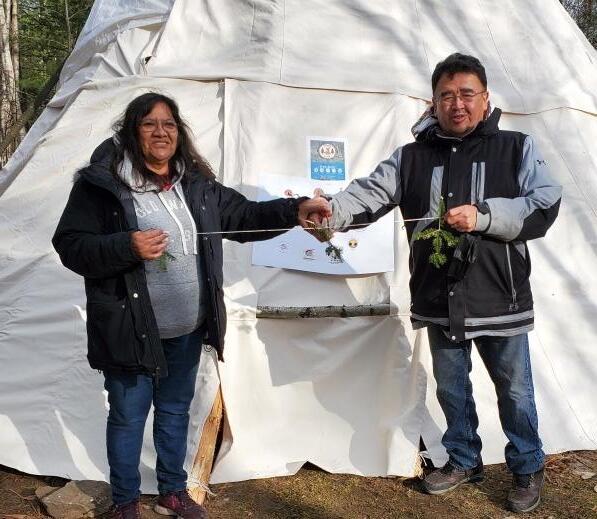
Features
10 the Nation January 13, 2023 www.nationnews.ca
Philip Matoush and his wife Sharon Pepabano
Mohawk-Cree
Teepee
project
sees grand opening event in Kahnawake
Mags Brien and her mother Elizabeth cut the ribbon December 9 to celebrate the grand opening of two “modern teepees” in Kahnawake. The cross-cultural project called the Mohawk-Cree Teepee has grown rapidly since Philip Matoush and his wife Sharon Pepabano began hosting humble campfires in 2020.
“If it wasn’t for the Mohawks and the Crees doing this together, this thing wouldn’t have been possible,” Matoush told the Nation.
“It’s come a long way – we started from scratch with a fire pit. Now it’s two modern teepees and we’re thinking of hooking up electricity for freezers to store all the wild meat.”
One of the permanent, hardwalled structures is named after Mags’ 14-year-old son, Elias Brien, who is originally from Mistissini but lives in Montreal to be closer to specialized medical appoint-
ments. Mags is grateful the teepees include easy access for Elias’ wheelchair and additional ventilation to alleviate his asthma.
With windows and winter insulation, these teepees simplify visits from Cree patients and escorts staying at Montreal’s Espresso Hotel for medical reasons. As a medical transport driver with Wiichihiituwin (Cree Patient Services), patients often told Matoush about they craved traditional foods roasted over the fire.
The urban bush camp began with traditional cookouts at Camping D’Aoust in Hudson, an hour west of Montreal. With the support of Cree volunteers and organizations, a teepee was built after the first summer. Since Bob Patton invited Matoush and Pepabano to relocate to his family’s beautiful property on the Mohawk reserve of Kahnawake, just a 15-minute drive from down-
town Montreal, the project quickly gathered steam.

The project’s immediate popularity – with numerous volunteers regularly contributing food, supplies and labour – demonstrated the need for a healing space close to the city. In addition to funding from the Cree Health Board and Kahnawake Shakotiia’takehnhas Community Services, Charlotte Coonishish and Charles Katapatuk helped secure funds from Mistissini and Waswanipi.
“We got the funding from Mistissini and Kahnawake in one day and it just steamrolled,” said Patton. “We got people from up north who came down and built the teepees within two weeks. We had such a grand opening with 150 people we cooked for – people were amazed.”
His father, Robert Patton Sr, welcomed guests with a group prayer at the event, which fea-
 Kahnawake opening ceremony with Charlie Patton
Kahnawake opening ceremony with Charlie Patton
tured guests such as Kahnawake Grand Chief Kahsennenhawe SkyDeer, Mistissini Chief Michael Petawabano and CHB chairperson Bertie Wapachee.
“I’d never tried turkey dumplings before, but I finally had the chance – it’s a Mohawk dish apparently,” shared Wapachee. “It’s a great achievement for the patients who always hoped for something long-term and closer. It was like the feasts back home.”
As the teepee project expands, the CHB is helping with monthly expenses for firewood supplies, garbage collection and snow clearing. While Matoush hopes to establish weekly transportation for Espresso patients, Wapachee told
Patton said it’s an ideal setting for alternative dispute resolution. Interest in the site has been expressed by Narcotics Anonymous and Alcoholics Anonymous. He hopes to soon offer Gladue Report aftercare, which considers an Indigenous person’s unique family and community history in court sentencing.
“When people are released from detention, they can be part of the teepee as part of their healing journey back to the community,” explained Patton. “We’re able to provide country food to help our inmates in jail – it gives them something to look forward to. The workers themselves are quietly healing.”
New Zealand was impressed with the goose cookout a few weeks ago. Matoush said two Inuit women who make handmade parkas are doing a photo shoot there and offered to bring some caribou meat from Nunavik.
“We’re building bridges between nations, all working together and sharing each other’s cultures and traditions,” asserted Patton. “We want to keep it political-free and grassroots. Like my grandmother always says, leave everything at the doorstep, everything comes with a good mind.”
There are plans to erect two traditional teepees, build more fire
“We’re building bridges between nations”
-Bob Patton
the Nation there are lingering liability concerns to be worked out.
“Anything can happen between the Espresso and the teepee going back and forth,” Wapachee explained. “We have to make sure the patients are protected and the organization as well. If it can work out, it would be great for the patients.”
The teepee is becoming a hub for healing and cultural activities, including partnerships with Cree Justice and Native Para-Judicial Services of Quebec, where Patton works as a Mohawk support worker. They’re also working with federal and provincial corrections departments. Five Indigenous men already completed court-ordered community service hours by cleaning and preparing moose meat.
While more visitors come in the warmer months, the teepee remained busy every weekend through this winter. In January, Kahnawake organizers and Waskaganish trappers came together to address a beaver overpopulation in the area, harvesting 10 beavers which were prepared by volunteers for a feast in the Mohawk longhouse.
“Bob just mentioned since we have a lot of snow now, they want to build a mountain for kids to slide down,” Matoush said. “There are lots of kids there having fun playing outside since they can’t do that in the city. They’re having a marshmallow or wiener roast at the teepee – it’s open to everybody.”
The initiative has welcomed folks from several First Nations and beyond – a Māori man from
pits, install picnic tables and to landscape the property. They hope to offer overnight stays and create sweat lodges at the site.
There’s potential for making it “a home away from home” while addressing food security for Cree patients by developing community gardens, believes Patton. He suggested raising chickens and turkeys for both meat and eggs, which could then be delivered to patients or sold to subsidize teepee expenses.
“It’s all about bringing nations together, learning from each other,” said Matoush. “That’s what I dreamt about when we started. We’re making new friends every day! It’s so relaxing there – I feel like I’m back home.”
12 the Nation February 24, 2023 www.nationnews.ca
With windows and winter insulation, these teepees simplify visits from Cree patients and escorts staying at Montreal’s Espresso Hotel for medical reasons

It’s an ideal setting for alternative dispute resolution. Interest in the site has been expressed by Narcotics Anonymous and Alcoholics Anonymous

the Nation 13

ᐧᐄᐦᑎᒫᒑᐧᐃᓐ ᐧᐋᒋᔮᒄ ᒥᓯᐧᐋ᙮ ᑳ ᐄᔥᐱᔑ ᐅᑖᔅᑯᓂᑭᐧᐃᔮᓐ, ᒥᐦᒑᑐ ᐊᐧᐋᓂᒌ ᓂᒌᐦ ᐹᐦᑎᐧᐋᐧᐃᒡ ᐋᐦ ᐧᐄᐦᑎᐦᒡ ᐋᑖᔨᐦᑎᒥᐦᐄᑯᒡ ᑭᔮᐦ ᐋᐦ ᒥᑯᔅᑳᑖᔨᐦᑎᒥᐦᐄᑯᒡ ᐅᐦᒋ ᐋᐦ ᐧᐄᐦ ᒥᒋᒥᓂᑭᓂᐧᐃᒡ ᐄᔨᔨᐅᔨᒧᐧᐃᓐ ᑭᔮᐦ ᔮᔨᑖ ᒑ ᐋᐱᑎᐦᒡ ᐅᑖᐦ ᒥᓯᐦᑖ ᐄᔨᔨᐅᔅᒌᐦᒡ, ᐋᑳ ᒥᒄ ᐅᑖᐦ ᐅᐦᒋ ᒋᔅᑯᑎᒫᑑᑭᒥᑯᐦᒡ ᑭᔮᐦ ᐊᓂᑖᐦ ᐋᐦ ᐧᐄᒋᔨᐦᒄ, ᐄᔨᔨᐤ ᒥᓯᓂᐦᐄᒑᐅᑭᒥᑯᐦᒡ, ᐋᐦ ᐱᒥᐱᔨᐦᑖᑭᓂᐧᐃᒡ ᐋᐱᑎᓰᐧᐃᓐ ᑭᔮᐦ ᐋᐦ ᒫᒨᐋᐱᑎᔒᔥᑎᑭᓂᐧᐃᒡ ᑭᔮᐦ ᐧᐃᔨᐱᔨᐦᑖᑭᓂᐧᐃᒡ ᓂᓈᐦᑭᐤ ᒑᐧᑳᓐ᙮ ᐊᓐ ᐋᔥᐱᔑ ᓅᑯᐦᑖᔨᐦᒄ ᐋᐦ ᒥᓯᓂᐦᐋᒥᐦᒄ ᐊᔥᑏᔨᔨᐅᔨᒧᐧᐃᓂᓂᐤ, ᐧᐄᒋᐦᐄᐧᐋᐱᔨᐤ ᐋᐦ ᒋᔥᑖᔨᐦᑎᒥᐦᒄ ᑖᓐ ᒥᒄ ᐋᐦ ᐄᔑ ᒥᓯᓈᑖᒡ, ᐋᐦ ᐄᔨᔨᐅᔥᑖᒡ ᑭᔮᐦ ᒫᒃ ᐋᐦ ᐧᐋᒥᔥᑎᑯᔒᐅᔥᑖᒡ, ᐋᐦ ᐧᐄᐦ ᒋᔅᒑᔨᐦᑎᔨᐧᐋᔨᐦᒄ ᓂᓈᐦᑭᐤ ᒑᐧᑳᓐ᙮ ᐋᑯᑎᐦ ᐧᐋᐦᑖᑯᐦᒡ ᓲᐦᒄ ᐋᐦ ᑯᒋᔥᑖᔨᐦᒄ ᐅᑖᐦ ᐄᔨᔨᐅᔅᒌᐦᒡ ᐋᐦ ᐧᐄᐦ ᒥᒋᒥᓂᒥᐦᒄ ᐊᔥᑏᔨᔨᐅᔨᒧᐧᐃᓂᓂᐤ᙮ ᐆ ᓃᐧᔖᐤ ᒑ ᐱᒥᐱᔨᒡ ᐄᔨᔨᐅᔨᒧᐧᐃᓐ ᐲᓯᒻ ᐊᑯᒋᐦᑳ ᒥᒋᓲᐲᓯᒻ 2023 ᐋᑯᑎᐦ ᒑ ᓅᑯᐦᑖᑭᓂᐧᐃᒡ ᐅᑖᐦ ᐹᐦᐹᔨᒄ ᐄᔨᔨᐤ ᐃᐦᑖᐧᐃᓂᐦᒡ ᐋᔥᐱᔑ ᒌᐦᑳᔮᔨᐦᑎᑭᓂᐧᐃᒡ ᐊᔥᑏᔨᔨᐅᔨᒧᐧᐃᓂᓂᐤ ᐋᔥᒄ ᐋᐦ ᐋᐱᑎᐦᒡ ᑭᔮᐦ ᐋᐦ ᒋᔥᑎᒫᐧᐋᔮᔨᐦᑖᑯᐦᒡ᙮ ᓂᒑᔥᑏᓈᐦᐅᓐ ᒥᓯᐧᐋ ᐄᔨᔨᐤ ᐃᐦᑖᐧᐃᓂᐦᒡ, ᐊᓂᑖᐦ ᐹᒥᐱᔨᐦᑖᑭᓂᐧᐃᒡ ᐋᐱᑎᓰᐧᐃᓐ, ᑭᔮᐦ ᐋᐦ ᒫᒨᐱᔥᑎᑭᓂᐧᐃᒡ ᓂᓈᐦᑭᐤ ᒑᐧᑳᓐ ᒑ ᐧᐄᒋᐦᑖᒡ ᑭᔮᐦ ᒌᐦᑳᓈᑯᐦᑖᒡ ᐄᔨᔨᐅᔨᒧᐧᐃᓂᔨᐤ ᐊᓂᑎᐦ ᒑ ᒌᐦ ᓅᑯᐦᒡ ᐊᔅᐹᔨᒧᐧᐃᓐ ᑭᔮᐦ ᐋᐦ ᔒᑐᔥᑭᑭᓂᐧᐃᒡ ᒑ ᒌᐦᑳᔮᔨᐦᑖᑯᐦᒡ ᐋᑳ ᒑ ᐧᐃᓂᐦᑎᐦᒡ ᐄᔨᔨᐅᔨᒧᐧᐃᓐ᙮ ᓃᔮᓐ ᐋᐦ ᒫᒨᐱᔥᑎᒫᐦᒡ ᑭᔮᐦ ᒥᔮᒨᐋᐱᑎᔒᔥᑎᒫᐦᒡ ᐄᔨᔨᐅᔨᒧᐧᐃᓐ, ᒥᔥᑏᐦ ᓂᑎᑖᔨᐦᑎᒥᐦᐄᑯᓈᓐ ᒑ ᒌᐦ ᐧᐄᐦᑎᒫᑖᐦᒡ ᐊᓂᑖᐦ ᐧᐋᐦ ᐄᔑᓈᑯᐦᑖᑭᓂᐧᐃᒡ ᐄᔨᔨᐅᔨᒧᐧᐃᓐ ᐋᑳ ᐴᓈᐱᑎᔒᔥᑎᒫᐦᒡ ᐊᓐ ᐧᐋᐦ ᐃᐦᑐᑎᒫᐦᒡ ᒑ ᐄᔑᓈᑯᐦᒡ᙮ ᒨᔥ ᒑ ᐱᒥᐱᔨᒡ ᑭᔮᐦ ᓈᑭᑎᐧᐋᔨᐦᑖᑯᐦᒡ ᐊᔥᑏᔨᔨᐅᔨᒧᐧᐃᓂᓂᐤ ᐋᔮᓂᔅᒑ ᐋᐦ ᐋᔔᒥᔨᑐᔨᐦᒄ᙮ ᓂᓯᒋᔮᓯᓈᓐ ᐋᐦ ᒌᐦ ᑖᐧᐹᐅᒑᔨᒥᑭᐧᐃᔮᐦᒡ ᒑ ᒌᐦ ᐃᐦᑐᑎᒫᐦᒡ ᐆ ᐋᐱᑎᓰᐧᐃᓐ ᑭᔮᐦ ᒨᔥ ᒋᐱᑯᓵᔨᒥᑎᓈᓐ ᒑ ᐹᒋ ᐱᒋᔅᑎᓂᒫᒄ ᐊᓐ ᐋᑖᔨᐦᑎᒫᒄ ᒑ ᐃᐦᑐᑎᑭᓂᐧᐃᑯᐱᓈ ᐋᐦ ᒫᒨᐧᐄᒑᐱᑎᓰᒥᑐᔨᐦᒄ᙮ ᐊᓐ ᒫᐦᒋᒡ ᒑᐧᑳᓐ ᐧᐋᐦ ᐧᐄᐦᑎᒫᓐ, ᒥᓯᐧᐋ ᒑ ᐧᐄᐦ ᒋᓯᒑᔨᐦᑎᒥᐦᐄᑯᔮᒄ ᒑ ᒌᐦ ᒌᐦᑳᔮᔨᐦᑖᑯᐦᒡ ᐄᔨᔨᐅᔨᒧᐧᐃᓐ ᐋᐦ ᐄᔨᔨᐅᔥᑖᔮᒄ ᒋᑎᓯᓂᐦᑳᓱᐧᐃᓂᐧᐋᐤᐦ ᓂᑐᐧᐋᐱᐦᒋᑭᓂᐦᒡ ᐋᐦ ᒥᓯᓂᐦᐄᒑᔮᒄ, ᐊᔨᒧᐧᐋᑭᓂᔑᐦᒡ, ᑭᔮᐦ ᐋᐦ ᐋᔨᒧᒫᑯᒡ ᐊᓂᒌ ᐊᐧᐋᓂᒌ ᐋᐦ ᒌᐦ ᐋᐱᑎᔒᔥᑎᐦᒡ ᐄᔨᔨᐅᔨᒧᐧᐃᓂᔨᐤ ᐊᓅᐦᒡ ᒫᐧᑳᒡ ᑭᔮᐦ ᐅᑖᐦ ᐄᔑ ᐅᑖᐦᒡ᙮ ᒨᔥ ᐧᐄᐦ ᒌᐦᑳᓈᑯᐦᑖᑖᐤ ᐊᔥᑏᔨᔨᐅᔨᒧᐧᐃᓂᓂᐤ ᐆ ᒦᓐ ᒑ ᐊᑎ ᐊᑯᒋᐦᒃ ᐲᓯᒻ ᐊᓂᑎᐦ ᒑ ᒌᐦ ᐅᐦᒋ ᒋᔅᒑᔨᐦᑖᑯᐦᒡ ᐋᔥᒄ ᐋᐦ ᐋᐱᒋᔥᑖᔨᐦᒄ ᐄᔨᔨᐅᔨᒧᐧᐃᓐ ᑭᔮᐦ ᒨᔥ ᒑ ᒌᐦᑳᔮᔨᐦᑖᑯᐦᒡ ᐅᑖᐦ ᐄᔨᔨᐅᔅᒌᐦᒡ᙮ ᐋᑯᑖᐦ, ᒋᓂᔅᑯᒥᑎᓈᐧᐋᐤ᙮ ᓃᔨ, ᒉᐃᒥ ᒧᓱᔅ ᐄᔨᔨᐅᔨᒧᐧᐃᓐ ᑭᓂᐧᐋᐱᒫᑭᓐ
ANNOUNCEMENT
ᐧWaachiyaakw misiwaa.
Over the course of my appointment, I have heard from many sharing their thoughts and concerns about ways ensuring the preservation and practise of our language is held as a priority throughout Eeyou Istchee not only in our schools, but also in our homes, b and offices, businesses and organizations.
The level of visibility we give to our language plays a role in the way we communicate our own efforts to the Cree Nation by using more Cree whether in syllabics or roman -orthography. In doing so, we display the commitment we have in ensuring our language thrives in our territory.
Our second annual Iiyiyiuyimuwin Piisimw is coming up this March 2023 with much anticipation to see how the communities will celebrate and highlight the vitality and presence of our language. I am confident each community, business, and organization will participate and promote our Cree Language in ways that will offer hope and encouragement that we are prioritizing the survival of Iiyiyiuyimuwin.

Together with my team and ad-hoc committee, we are proud to share our vision statement for Cree Language as we keep working towards a common goal,. To nurture and maintain the continuous growth and vitality of our Cree language for all generations. We are humbled by this work, value the trust instilled to do this work and we always welcome your thoughts and ideas on ways to work together.
In closing, I encourage all to promote our language by using Cree syllabics in your email signatures, on your social media, and by sharing stories of people who have worked in Cree Language either past or present. Let’s showcase our language in all that we do this coming month to make a statement that our language is very much alive and will remain vibrant in the Cree Nation.
Aakutaah, thank you.
Niiyi Jamie Moses Commissioner of the Cree Language
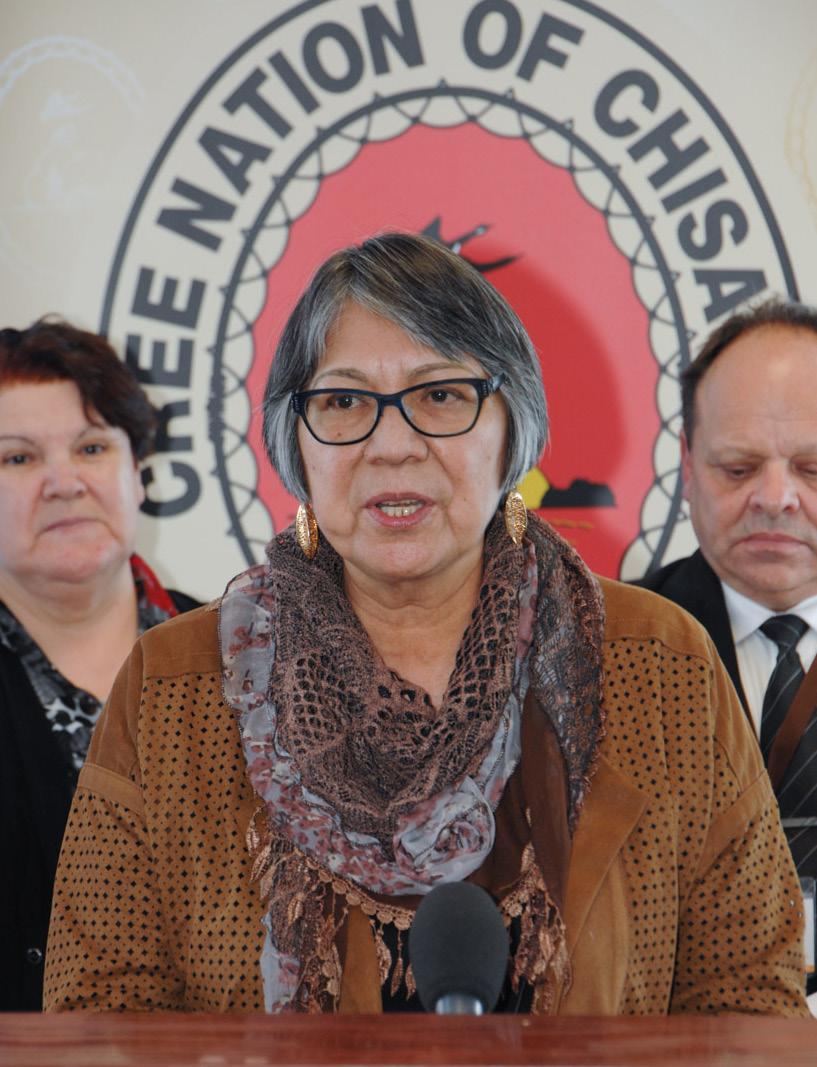
Bella’s honours
by Ben Powless
Former CHB chair Petawabano twice recognized for her leadership in healthcare
Former Cree Health Board Chairperson
Bella Petawabano was awarded with two distinctions during the past few years, she revealed in an interview with the Nation
Unreported until now, Petawabano revealed that she received the Excellence in Health Leadership Award from the First Nations Health Managers Association in November 2020. More recently, she was honoured with a governance award by the Canadian Red Cross, on whose board of directors she sat from 2018 until 2022.
“I was surprised. I didn’t expect to receive an award like that. I was very honoured,” she said. “It’s one thing to be recognized in your own community for your contributions, but it’s another thing to be recognized at a national level. I’ll keep this award close to my heart.”
The Red Cross supports communities in times of disaster, including floods, earthquakes, fires, and most recently, during the pandemic. The organization works with sister agencies across the globe, making up what it calls the largest humanitarian network in the world with organizations in 192 countries.
Petawabano said the Red Cross wanted to invite an Indigenous person onto their board of directors. Someone recommended she be invited, owing to her position as CHB chair.
During its national general assembly, Petawabano worked with Dr. Darlene Kitty and former Assembly of First Nations National Chief Phil Fontaine to deliver a presentation on cultural safety. “I was
proud and privileged to have that experience, to be part of the board of directors,” she said.
She said the organization ensured Indigenous protocols were followed when going into Indigenous communities, such as when they responded to the 2015 Fort McMurray wildfire, which impacted several nearby First Nations.
“They’re very mindful of making sure they’re involving the First Nations in the work they do. They don’t just go in and do what they think is best,” she explained. “They have them involved from beginning to end.”
Petawbano said that it reinforced the work she and the health board were already undertaking. In 2018, the CHB visited emergency response units near Toronto that were designed for use in remote areas to coordinate medical, logistical and communications responses.
The CHB purchased two of the units and 600 cots from the Red Cross, to increase response capacity during wildfires and flooding in Cree communities. They help keep evacuees in Eeyou Istchee rather than sending them to places like Val-d’Or. Petawabano said the pandemic was not on anybody’s mind at the time.
“What we wanted to do was keep people in Eeyou Istchee so if ever that happened, we wanted to be able to have a mobile-hospital type of setting we can set up in another community and have people from the other community impacted by
whatever disaster, along with the medical staff of their clinic,” she explained.
However, after Covid struck, the CHB deployed the emergency response units to the Chisasibi hospital. Petawabano said it was the only time the units were deployed so far.
The Red Cross was present in remote Indigenous communities across Canada, delivering supplies, testing and conducting vaccinations. But Petawabano said Cree communities did not meet the level of need, thanks to the response of health authorities. That’s the reason Petawabano received the other award back in 2020.
“The Cree Health Board started working on this in January [of 2020], looking at how we can respond with our resources, knowing the state and wellbeing of the Cree Nation. But it wasn’t until midMarch that we all got together with the Cree Nation Government to talk about what we were going to do,” she said.
As a result of the actions taken by Cree authorities at all levels, the communities were less affected by the pandemic than elsewhere.
Petawabano said she didn’t feel right about boasting about the award while the pandemic was ongoing, however. The award ceremony was also very low-key –a zoom presentation online.
“I had to do my acceptance of the award by video, which I did and I just sent it in. So, I sat in my living room and I watched it by myself,” she said with a laugh.
www.nationnews.ca February 24, 2023 the Nation 17
Local Journalism Initiative Reporter
Photo by Gaston Cooper
Unlocking the wealth

Historic home ownership transfer in Ouje-Bougoumou
by Patrick Quinn Local Journalism Initiative Reporter
Seven families in Ouje-Bougoumou are celebrating becoming the community’s first private homeowners. It was 30 years in the making, the culmination of the housing program’s vision developed when the community was established in the early 1990s.
The sales agreements were signed January 24 with the housing pioneers who completed the final steps of this program by paying off their mortgages, outstanding loan balances and community service fees while securing private home insurance. The community’s Home Ownership Program will formalize this process with 16 more homeowners once they confirm they have home insurance.
“I’m quite proud of that accomplishment,” said housing director Minnie Wapachee. “When the community was initially built, the whole housing program was designed around home ownership. Now we’re getting tangible results, I think we’ll get more response from people who want this next step done.”
The innovative housing program was integral to its award-winning design, with energy-efficient homes built with the objective of making ownership available to as many people as possible. Having the advantage of being the most recent village built in Eeyou Istchee, early leaders intentionally avoided accommodating most people through Cree Nation Government social housing programs as other communities do.
For the 119 houses built through this home ownership program in its first 20 years, community members entered into sales or rent-to-own agreements, committing to pay the acquisition cost which was generally half of construction costs. However, Ouje-Bougoumou wasn’t federally recognized under the James Bay and Northern Quebec Agreement as a band until a land transfer agreement was signed with Mistissini in 2012.

When the CNG succeeded in removing a 75-year limit on residential land leases in 2019 – a systemic barrier that keeps many First Nations dependent on social housing – it introduced the Community Private Housing Initiative the following year. After individual lots were transferred to potential homeowners as a perpetual lease, the OBCN housing program was finally able to formally sell the structures.
Among the 60 community members who paid their first mortgage, those who proactively maintained or improved their homes while paying the bills were prioritized for ownership. One ideal client took responsibility for major repairs and now has the most modern-looking house on the block.
“Knowing how they’ve taken care of these homes, we started off with what I consider the easier clients,” Wapachee told the Nation. “There are individual cases where I know people will take care of these homes from now on. No strings attached, sell it if you want, pass it on to your children – it’s your property.”
Once the process is finalized with the Quebec Land Registry, these houses will be legally transferred. However, others in the program made less effort to pay expenses and may never achieve
18 the Nation February 24, 2023 www.nationnews.ca
Community
ownership. Wapachee speculated some were willing to fulfill the agreement but were discouraged by various restrictions along the way.
“Over the years, there’s been this unhealthy reliance on the bands to take care of these homes when the ownership wasn’t clear,” asserted Wapachee. “You’re expected to embrace this home ownership program, but you don’t have full independence. Some of these homes have deteriorated more than they needed to, waiting for our renovation program to get to them.”
Although issues remain with overcrowded homes, non-payment and renovation needs, this program provides is one solution to the Cree Nation’s housing crisis. Additional federal funding for social housing received last year should create 750 new units across Eeyou Istchee over the next four years.

Through the Private Housing Initiative, local Cree governments can now use subsidies to build units for community members or help individuals build their own houses in the community. Wapachee suggested people living with adult children may want to rent their house to them as an income property and then build their own empty nest home.
“It’s really opened doors for people to build their family homes,” said Wapachee. “They can fast-track their building and not rely on us. There is no waiting list now – if you’re ready to build, do it. The biggest challenge now is the cost of everything. That’s the main barrier.”
While it’s no small challenge to own a house, Wapachee believes demand will increase now that people can witness the rewards within reach. New homeowners like Sydney Coonishish are encouraged by seeing how much their investment has appreciated in value.

“That excitement has been rekindled,” Coonishish told the Nation. “We’d kind of neglected it for a while but when we knew about this, we started to rearrange our house. Planning renovations, extensions and how we’re going to change the layout. It motivated us again.”
For Coonishish’s daughter and her spouse, who attended the signing ceremony, this asset represents financial security and collateral that offers the ability to buy a home in Ottawa as their children prepare for college or university.
A resident since the community’s beginnings, Coonishish was grateful for the vision and perseverance of those who supported the program. Before semi-retiring in 2018, Coonishish was involved in the cadastral survey of residential lots, which delineates land claims for the issuance of titles.
“Back in 1993 when we were starting to build Ouje-Bougoumou, one of the first things that got everyone excited was choosing the lot where you wanted to build,” recalled Coonishish. “My parents decided to build right beside me, my wife’s parents are across the street and everyone was around us.”
After the signing ceremony, Coonishish and his wife cooked up tomahawk steaks to celebrate the occasion. They’re hoping to plan a housing symposium once all the documents are produced, sharing with future homeowners the benefits of acquired wealth.
“I can’t say thank you enough to all those people who kept the momentum going on this dream that we had,” said Coonishish on the way to his camp, joking he may have to call it a “lakeside residence” one day. “I hope one day we all get together and celebrate this very special time in our young community. I’ll remember this a long time.”
www.nationnews.ca February 24, 2023 the Nation 19
Not a drop to drink
First Nations, individuals now have until March 7 to claim compensation for water advisories
by Ben Powless Local Journalism Initiative Reporter
In 2021, Federal Court approved a class-action settlement between Canada and several First Nations that were subject to long-term drinking water advisories from 1995 to 2021. Now, settlement negotiators have extended the deadline for First Nations to submit a claim until March 7.
If the Band Council Acceptance Resolution that a First Nation files with the settlement administrator is accepted, it will receive a $500,000 base payment and be eligible for additional payments of up to 50% of the amounts paid to eligible individuals in the community.
The overall settlement was for $8 billion, which included $1.5 billion in compensation for individuals; $400 million in compensation for First Nations communities; $50 million for individuals who experienced injuries due to drinking water advisories; $6 billion for construction and maintenance of water infrastructure in First Nations communities; and the federal government’s commitment to end drinking water advisories across Canada.
Canada agreed to spend at least $6 billion and “make all reasonable efforts” to end drinking water advisories by March 31, 2030, including funding the construction and maintenance of water treatment facilities.

Individuals also have until March 7 to submit their claims for “signifi-


cant and long-term health problems that have harmed your quality of life and disrupted your wellbeing and/or daily activities,” according to the settlement. The settlement outlines nine types of harm that are included, which are: digestive, respiratory, dermatological, liver, neurological, bloodstream infections, kidney, tumors or cancer, and mental health.

Individuals are also eligible for payments for the period they lived in a First Nation community that experienced a drinking water advisory between November 20, 1995, and June 20, 2021. For those in remote First Nations, that could average about $2,000 per year. For non-remote First Nations, that could amount to $2,000 for do-not-use advisories, $1,650 for do-not-consume advisories, and $1,300 for boil-water advisories, per year.
The class action lawsuit started in 2019 with Neskantaga First Nation, Curve Lake First Nation and Tataskweyak Cree Nation contracting Olthuis Kleer Townshend LLP and McCarthy Tétrault LLP, suing the federal government for failing to ensure safe
drinking water was available in First Nations communities.
No Cree communities in Eeyou Istchee are listed as impacted First Nations. Only communities that had drinking water advisories lasting more than a year are eligible. In total, 321 First Nations are listed. Five are excluded from participating in the settlement since they are part of other claims.
“Why does this have to happen? Why did we have to sue the government in order to get this thing to where it is today?” Neskantaga Chief Wayne Moonias said during a press conference announcing the original settlement. “We have suffered so much, we have lost so much, we have endured so much. But our community continues to be resilient. We know how hard it is if you don’t have the basic necessities of life.”
Prime Minister Justin Trudeau originally pledged to provide clean drinking water for all First Nations by March 2021. Currently, there are 32 drinking water advisories in 28 communities across the country, most of which are in Ontario.
an Indigenous woman of Eeyou Istchee and you
seeking
and support, we are here to help you!
/services/womens-shelters-robins-net Pîpîchâu Uchishtûn For women and children of Eeyou Istchee suffering from domestic violence
855 753-2094 CRISIS LINE
If you are
are
safety
creehealth.org
1
ᐐᒋᐦᐄᐙᐅᐎᓐ WÎCHIHÎWÂUWIN HELPLINE If you need emotional support or to learn about all the services available to you, please contact us:
833 632-HELP (4357) creehealth.org
Toll Free | Open 24/7
1
Community Politics
A big tent
Algonquin College vastly expands Indigenous Centre offerings
 by Ben Powless, Local Journalism Initiative Reporter
by Ben Powless, Local Journalism Initiative Reporter

Ottawa’s Algonquin College is expanding the role of its Mamidosewin Centre for Indigenous students.

Mamidosewin Centre Manager Eric Johnston said the college is investing in the centre to make it akin to a “home room” for Indigenous students on campus.
The centre already has a student lounge which includes TVs and video games, a kitchenette, a computer lab, fax and phone services, access to smudging and medicines, and an emergency food bank. But it will soon offer more services, such as cultural education.
The centre’s focus will soon include lectures about Indigenous history, Johnston said, “What really took place in residential schools, how is the Indian Act policy of assimilation attached to all that? There’s quite a bit of historical perspective that Mamidosewin also tries to play a fostering role in.”
The goal is to provide students a better sense of where they come from, the history of their nations, and how they can assist their communities. To that end, the college is turning the existing one-year Native Studies curriculum into a two-year program.
Johnston said many Indigenous students choose programs such as construction, business administration, policing, and social work. However, he said there’s room for students who don’t yet know what they want to study, and who may need assistance with their math or writing skills in the meantime.
Johnston studied legal administration and colonial history after growing up on the Chippewas of Nawash Unceded First Nation in Ontario. From there, he worked in California before being hired at the University of Toronto’s Indigenous Centre. He moved to Algonquin College last year.
For students living in a city environment for the first time, the centre supports them with a student residence, meals and urban orientation activities. However, Johnston said there are still housing issues.
“The colleges are aware that residence is a rising challenge, no matter where you come from,” he said. “Getting a place at the residences is a real competitive kind of environment.”
Proposals to deal with the issue included reserving up to 60 of the 450 available residence spaces for Indigenous students, or that the college purchase a hotel and convert it into an Indigenous residence.
Johnston encourages students coming from the same community to rent apartments together. “It used to be you could look for residence in August or July, but now you have to start looking in May and April to scout out possibilities and make sure that a student has a good situation they’re dropping into,” he said.
This has been helped by the centre’s new relationship with the Registrar’s Office, which provides a list of incoming students and their communities, allowing the centre to contact students directly.
The centre then informs students about events, workshops, academic coaching, peer tutoring and bursary opportunities. Johnston hopes to organize meetups within study programs, so that all Indigenous students studying construction, for instance, could get to know each other.
The centre helps students complete bursary applications, including the emergency bursary fund or Indigenous-specific bursaries, like Indspire. This helps in cases when communities cannot fully fund students, which impacts their ability to pay for things like food and rent.
Other events that the centre organizes includes marking National Truth and Reconciliation Day in September and a round dance in March. They’re also working to bring in big drum teachings from the Lake of the Woods area to “strengthen the Indigenous identity and worldview in the educational institution,” Johnston explained.
www.nationnews.ca February 24, 2023 the Nation 21
Community




importance of life insurance, ouwahstore@gmail.com www.ouwahstore.com (514) 588-3162 18 Fort-George Road 22 the Nation February 24, 2023 www.nationnews.ca
Where can you pick up a fresh copy of your Nation every two weeks?
Where can you pick up a fresh copy of your Nation every two weeks?
Where can you pick up a fresh copy of your Nation
Let’s cheer these amazing businesses listed below…
Let’s cheer these amazing businesses listed below… Nation is available there!
– Retro Daze Cafe | T: 819-855-1847
Nation is available there!
– Retro Daze Cafe | T: 819-855-1847
– Bake Cree Restaurant | T : 819-855-6344
– Bake Cree Restaurant | T : 819-855-6344
– Cree Mart Grocery Store | T: 819-855-1765
– Cree Mart Grocery Store | T: 819-855-1765
– Ouwah Store | T: 514-588-3162
– Ouwah Store | T: 514-588-3162
Ouwah Store | T: 514-588-3162
– Eastmain Grocery Store
– Eastmain Grocery Store
T: 819-977-0283
T: 819-977-0283
819-977-0283
– Smokey Hill Grocery
– Smokey Hill Grocery T: 819-895-2727
Let’s cheer these amazing businesses listed below… Nation is available there! – Retro Daze Cafe | T: 819-855-1847 – Bake Cree Restaurant | T : 819-855-6344 – Cree Mart Grocery Store | T: 819-855-1765
T: 819-895-2727
– Whale Mart
– Whale Mart
Whale Mart
– Waswanipi Grocery
– Waswanipi Grocery T: 819-753-2514
T: 819-753-2514
819-753-2514
in Whapmagoostui in Chisasibi in Wemindji in Eastmain in Nemaska in Waskaganish in Waswanipi in Oujé-Bougoumou
– Wemindji Community Store
T: 819-978-3656
819-978-3656
– Nemaska Grocery
Smokey Hill Grocery T: 819-895-2727 Where can you pick up a fresh copy of your Nation every two weeks? Let’s cheer these amazing businesses listed below… Nation is available there! – Retro Daze Cafe | T: 819-855-1847 – Bake Cree Restaurant | T : 819-855-6344 – Cree Mart Grocery Store | T: 819-855-1765 – Ouwah Store | T: 514-588-3162 – Eastmain Grocery Store T: 819-977-0283
– Nemaska Grocery T: 819-673-2525
T: 819-673-2525
–in Mistissini
– Wemindji Community Store T: 819-978-3656 – Whale Mart – Waswanipi Grocery T: 819-753-2514
in Whapmagoostui in Chisasibi in Wemindji in Eastmain in Nemaska in Waskaganish in Waswanipi in Oujé-Bougoumou
– Meechum Reg’
418-923-3217
T: 418-923-3217
in Mistissini
in Mistissini
Whapmagoostui in Chisasibi in Wemindji in Eastmain in Nemaska in Waskaganish – Nemaska Grocery T: 819-673-2525 – Casey’s Depanneur and Gaz T: 418-745-3211
in Mistissini
– Casey’s Depanneur and Gaz
– Casey’s Depanneur and Gaz
– Wemindji Community Store T: 819-978-3656 Always available for download at: nationnews.ca
available for download at: nationnews.ca – Meechum Reg’ T: 418-923-3217
T: 418-745-3211
for download
nationnews.ca
Always available
at:
every
weeks?
–
–
–
–
– Nemaska Grocery T: 819-673-2525 – Casey’s Depanneur and Gaz T: 418-745-3211 – Smokey Hill Grocery T: 819-895-2727 – Wemindji Community Store T: 819-978-3656 Always available for download at: nationnews.ca in Whapmagoostui in Chisasibi in Wemindji in Eastmain in Nemaska in Waskaganish in Waswanipi in Oujé-Bougoumou in Mistissini Where can you pick up a fresh copy of your Nation every two weeks?
businesses
Nation is available there! –
Daze
–
–
–
– Eastmain Grocery Store T:
–
– Waswanipi Grocery T:
–
T:
–
–
–
T:
Always available for download at: nationnews.ca in Whapmagoostui in Chisasibi in Wemindji in Eastmain in Nemaska in Waskaganish in Waswanipi in Oujé-Bougoumou
two
–
Eastmain Grocery Store T:
Waswanipi Grocery T:
Meechum Reg’ T: 418-923-3217
Let’s cheer these amazing
listed below…
Retro
Cafe | T: 819-855-1847
Bake Cree Restaurant | T : 819-855-6344
Cree Mart Grocery Store | T: 819-855-1765
Ouwah Store | T: 514-588-3162
819-977-0283
Whale Mart
819-753-2514
Meechum Reg’
418-923-3217
Nemaska Grocery T: 819-673-2525 – Casey’s Depanneur and Gaz T: 418-745-3211
Smokey Hill Grocery T: 819-895-2727
Wemindji Community Store
– Meechum Reg’ T:
Always
in
T: 418-745-3211 in Waswanipi in Oujé-Bougoumou
Here’s another edition of the Nation’s puzzle page. Try your hand at Sudoku or Str8ts or our Crossword, or better yet, solve all three and send us a photo!* As always, the answers from last issue are here for you to check your work. Happy hunting.
SUDOKU
Previous
How
You can find more help, tips and hints at www.str8ts.com No. 639 Very Hard Previous solution - Tough
For many strategies, hints and tips, visit www.sudokuwiki.org

24 the Nation February 24, 2023 www.nationnews.ca ACROSS 1 Blows away 5 Kind of therapy 10 Stomach woe 14 Barn topper 15 Long-necked wader 16 Urgent request 17 Priceless 19 Pilot products 20 Doer of do's 21 Exit, as a 747 23 Old anesthetic 25 Kidney-related 26 Kitchen fixture 29 Warren denizens 32 Indiana hoopsters 34 Hammer part 35 Car nut 38 Public praise 40 Pass away 42 "___ rang?" 43 Pre-weekend shout 68 Humble 11 Fresh start 39 Start for way or 45 Addams Family 69 Off-color 12 Reddish dye wife uncle 13 Studio stand 41 Out of the 46 Pirate treasure DOWN 18 English major's ordinary 49 Kind of whale 1 Hertz rival field 44 Spoon-___ 50 Word with way 2 Long for 22 Disney's Ariel 47 On the market, or well 3 Coveter's and Aurora as a house 52 Tightly packed emotion 24 Jay-Z's genre 48 Pass on, say 54 Colorful marble 4 Death Valley is 26 Fix, at the vet's 50 Knock, with "at" 57 Work boot below it 27 Tex-Mex snack 51 China setting features 5 "Pipe down!" 28 Line of work 53 Like a busybody 61 Life preserver? 6 Warming device 30 Four-poster, e.g. 55 Ketch's cousin 62 Easy to reach 7 Planet, poetically 31 Carne, in some 56 Reverberate 64 Ice ___ 8 Hard-hearted chili 58 Up to the task 65 2% alternative 9 On bended ___ 33 Aries or Libra 59 Farm machine 66 Natural soother 10 Small Java 36 Sure anagram 60 Bird feeder filler 67 ____ for oneself program 37 Start of an idea 63 Pasture grazer
Copyright 2023 by The Puzzle Syndicate 1 2 3 4 5 6 7 8 9 10 11 12 13 14 15 16 17 18 19 20 21 22 23 24 25 26 27 28 29 30 31 32 33 34 35 36 37 38 39 40 41 42 43 44 45 46 47 48 49 50 51 52 53 54 55 56 57 58 59 60 61 62 63 64 65 66 67 68 69
Crossword by Margie E. Burke
Puzzles
to Crossword: A D O R N A C H E B O T S R U P E E S H E D U R A L I M A G O S O M E P L A C E S P L I N T E R M E L L O W E Y E S U N A W A R E S T A R T L E S T A M P R E C E N T E L M O B A A O V E R A L L L A N O L I N D E N L E A P R A V E N S E N T R Y C A S T L E S E S T E L L E R E A M A F F A I R P A N O R A M A C L A S S I C A L F U M E S T O T O A U T O F L A N K S E E N D E E M S E N D S 92 3 9 2367 4278 38 4 4 15 6 © 2023 Syndicated Puzzles 138 936 357 6245 48 9247 954 519 421 © 2023 Syndicated Puzzles 731982465 649157832 825634197 576348219 213579648 984261753 397426581 168795324 452813976 STR8TS No. 639 Medium 326879 231476 4123867 321478 7412635 985324 8675234 563142 567823 8 5 6 9 7 1
to beat
–
PREVIOUS SOLUTION: Solution solution - Easy
Str8ts
Like Sudoku,
no single number can repeat in any row or column. But... rows and columns are divided by black squares into compartments. These need to be filled in with numbers that complete a ‘straight’. A straight is a set of numbers with no gaps but can be in any order, eg [4,2,3,5]. Clues in black cells remove that number as an option in that row and column, and are not part of any straight. Glance at the solution to see how ‘straights’ are formed.
To complete Sudoku, fill the board by entering numbers 1 to 9 such that each row, column and 3x3 box contains every number uniquely.
If you like Str8ts check out our books, iPhone/iPad Apps and much more on our store. The solutions will be published here in the next issue.
All in a day
by Sonny Orr
Igot up this morning, a little dry and kind of hot, the furnace gradually heating up the house. After knocking over a few things in the kitchen, I discovered the light wasn’t on and the room was lit up by the sun. Wow, the sun is getting up before me I think aloud, tossing a few more things around. Where’s the coffee when you need it most? Finally, I find the last cache of coffee pods and now the aroma of morning opens my eyelids, and my senses slowly start working again.
Ahh, the bacon sizzles, the coffee drips, the toast is slightly burnt, and eggs are cooked to perfection. No butter, no problem, cheese spread will do in a pinch. Finally, the messages pour in for my chauffeur duties – pick up kids and take them to school and daycare.
I look out the window and it doesn’t seem too bad today. Donning a second sweater and hoodie, plus a third pair of socks and warm mittens, I step outside to start up my vehicle. I nearly faint from the hot air as the temperature has risen 20 degrees in the last six hours reaching a balmy minus six. Arrgg! Overdressed and unprepared for the sweltering heat, I drive off and eventually deliver five kids and two adults to their destinations on time.
Walking into my office, I remove my outerwear and wipe the sweat off my brow, and then realize that in five weeks, spring will be here! Almost time to get ready for goose hunting! Wow, how time flies when nature is in a rush.


Just one missing gear in the web of life and kaboom!
After a long weekend of hockey tournaments, work is a nice respite. I attended as much as I could, but a grandfather’s duties – cooking, laundry and other household chores – needed to be done, so I did them.

The tournament ends and the household once roaring with loud, rowdy children is quiet now. The event has drained the kids’ energies and left them tired. I enjoy the quietness the tiredness creates and look forward to waking up early in the morning to head back to work. Really.
The morning coffee starts kicking in and then realize the boil water advisory I’m reading is a day old and I quickly spit out my still savory coffee. Wow, that

was close, I could have caught diphtheria or something else unpronounceable. The bottled water jugs magically appear, and my certified safe coffee is ready to consume.
Then the cell rings and the buses are out of action again. It’s the mad scramble to find the kids in a combination traffic jam and children everywhere scenario.
After a few harrowing minutes, the precious cargo is in the car and ready to head home for lunch. Later, the task is repeated during the after-school rush, followed by a last call at the daycare. Whew, I think, just one missing gear in the web of life and kaboom! Complete madness I tell you.
www.nationnews.ca February 24, 2023 the Nation 25
Rez Notes
T T T
by Maïtée Labrecque-Saganash

Icannot believe I am writing this, but today I tuned into WhiteHouse.org to get an update on the unidentified flying objects shot down by fighter jets in the United States and Canada. White House Press Secretary Karine Jean-Pierre, to my great relief, revealed that “There is no indication of aliens or extra-terrestrial activity with these recent takedowns.”

The US military said their prime suspect was – you guessed it – China. I really hate the fact that every time we talk about those intel and territorial integrity issues, the military always manage to make it sound like a bad action movie from the Cold War. We can’t have a serious debate because the information officials give us is limited and biased, much like a ping pong game of vague details about some kind of “reasonable threat”, whatever that means.
What we know so far is that China does have a balloon program and that we don’t know for sure whether these objects were part of it or were sent intentionally. Of course, China possibly collecting intel with balloons is bad. But let’s also remember that the US has military bases in many countries they have no business being in. There’s no ethical imperialism.

The other thing that I really hate is seeing the amount of fake news stemming from this kind of coverage. Now might be a good time to remind you to always factcheck what you read on social media and that there is a plethora of independent news outlets out there that are usually
more neutral and trustworthy than some random guy’s post on Facebook.

Experts do agree that the more you look skywards, the more things you will notice and that it wouldn’t be the first time we intercept intel devices in North American airspace. Three of the four objects taken down recently were shot down faster than the first one, because they were flying at altitudes where accidents with aircrafts would have been possible, so we’re not in a Denis Villeneuve sci-fi movie and about to meet aliens.
Imperialist states spying on each other is not new and it would be exaggerated to believe our physical integrity in Canada is immediately at stake because of these UFOs. It is kind of sad that this was blown out of proportions when more than 40,000 people just died in Turkey because of an earthquake, which is something very tangible. This whole balloon ordeal is just giving countries other reasons to vilify each other as if there’s not enough conflict in the world already, like the war in Ukraine entering its second year.

26 the Nation February 24, 2023 www.nationnews.ca
www.underthenorthernsky.com
Bannock T&B Wehavebeenpresent since1939.Allmembers ofthelargeDeshaies' familyarebyyourside todayandwillalsobe forthebetterdaysto come.
Tea &
UFOs

If you are an Indigenous woman of Eeyou Istchee and you are seeking safety and support, we are here to help you! creehealth.org/services/womens-shelters-robins-net Pîpîchâu Uchishtûn | Robin’s Nest | Women’s Shelter For women and children of Eeyou Istchee suffering from domestic violence 1 855 753-2094 CRISIS LINE Toll Free | Open 24/7 HELP ᐐᒋᐦᐄᐙᐅᐎᓐ WÎCHIHÎWÂUWIN HELPLINE If you need emotional support or to learn about all the services available to you, please contact us: 1 833 632-HELP (4357) creehealth.org


We offer discounted rates and seat sales. For information, reser vations, or charters call: 1-800-567-6567or visit: www.aircreebec.ca Your Northern Airline of Choice












 by Will Nicholls
by Will Nicholls











 Kahnawake opening ceremony with Charlie Patton
Kahnawake opening ceremony with Charlie Patton











 by Ben Powless, Local Journalism Initiative Reporter
by Ben Powless, Local Journalism Initiative Reporter
















